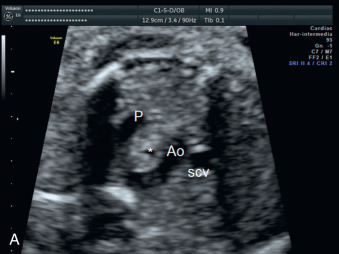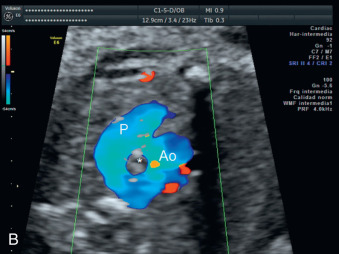Abstract
Aortic arch anomalies are a rare incidental finding during routine echocardiography. Active searching for these signs improves the detection rates. The prognosis is normally very good in isolated cases, and surgical correction to improve symptoms of constriction is required only rarely.
Keywords
congenital heart defect, aortic arch anomaly, vascular ring
Disease
Definition
Most frequent AA anomalies include right aortic arch (RAA) anomaly and aberrant right subclavian artery (ARSA ) . RAA anomaly consists of an abnormal aortic course in which the ascending aorta surrounds the trachea by its right side (instead of by the left). In ARSA, the subclavian artery arises directly from the descending aorta after the left subclavian artery branching and reaches the right arm passing behind the trachea, esophagus, and other vascular structures.
Prevalence and Epidemiology
AA anomalies are frequent in pediatric series but prenatal reports are scarce, because obtaining the required view and diagnosing requires training. The use in routine scans of the three-vessel and trachea view has improved diagnosis and understanding of normal and abnormal variants of the aortic arch.
ARSA is the most frequent aortic arch anomaly, affecting 1% of the fetal population. RAA anomaly affects 0.1% of adult population, being the second most frequent potentially symptomatic vascular ring after double aortic arch (DAA).
Etiology and Pathophysiology
The embryologic development of the aortic arch initially includes a double arch, each with a ductus arteriosus, both connecting with the descending aorta. Branches for the common carotid and subclavian arteries arise from right and left arches. Normal development entails regression of the descending right aortic arch just after the origin of the subclavian artery branching. Several aortic arch abnormalities may appear when this process does not occur normally:
- •
Mirror-image RAA is formed by the regression of the left aortic arch distal to the origin of the left subclavian artery together with persistence of the right one.
- •
RAA with aberrant left subclavian artery is due to left aortic arch regression between the left carotid artery and the subclavian artery. In this RAA variant, the left carotid followed by right carotid and right and left subclavian arteries arise from the RAA.
- •
RAA with aberrant retroesophageal left innominate artery occurs when the left aortic arch is interrupted before the left carotid artery.
- •
Left aortic arch with ARSA or innominate artery is formed by the regression of the RAA between the right common carotid artery and subclavian artery, or before the right common carotid artery (innominate artery).
- •
DAA is formed by persistence of both the right and the left arch.
Manifestations of Disease
Clinical Presentation
AA anomalies can be asymptomatic or manifest with clinical symptoms from tracheal (persistent stridor or upper airway obstruction) or esophageal (swallowing difficulties) compression secondary to vascular ring formation. DAA is the most frequent symptomatic form.
AA anomalies, especially RAA with mirror image, are frequently associated with other CHDs, such as tetralogy of Fallot and ventricular septal defects. In these cases, there is a high association with chromosomal abnormalities and 22q11 microdeletion. Demonstration of a normal thymus excludes 22q11 microdeletion with 90% negative predictive value (see Chapter 6 ). ARSA is a marker for Down syndrome, with a positive likelihood ratio of 3.94 when isolated.
Imaging Technique and Findings
Ultrasound.
Aortic arch anomalies usually are identified in the three-vessel and trachea view on ultrasound (US). The typical V shape of the pulmonary and aortic artery is lost ( Fig. 84.1A ).
- •
Mirror-image RAA: the aortic arch runs by the left side of the trachea ( Fig. 84.1B and Fig. 84.2 ).


Fig. 84.2
Color Doppler in the three-vessel and trachea view in a case of right aortic arch. The aorta (Ao) is identified to the right of the trachea (asterisk), next to the superior caval vein (SCV). P , Pulmonary artery.
Stay updated, free articles. Join our Telegram channel

Full access? Get Clinical Tree








